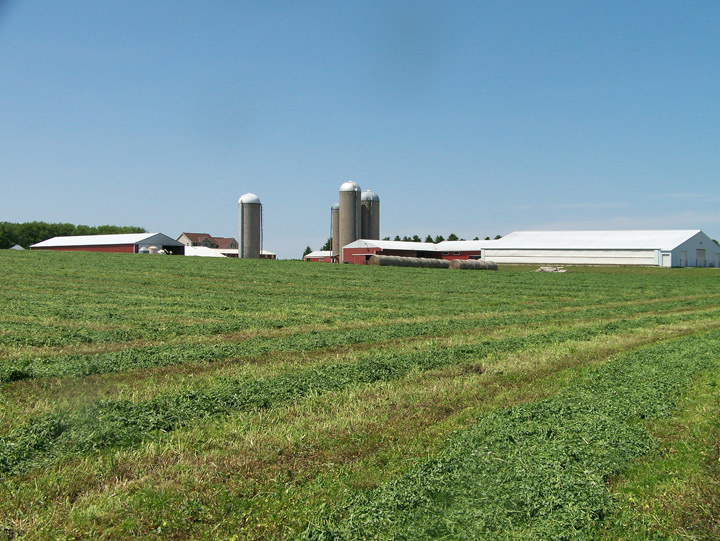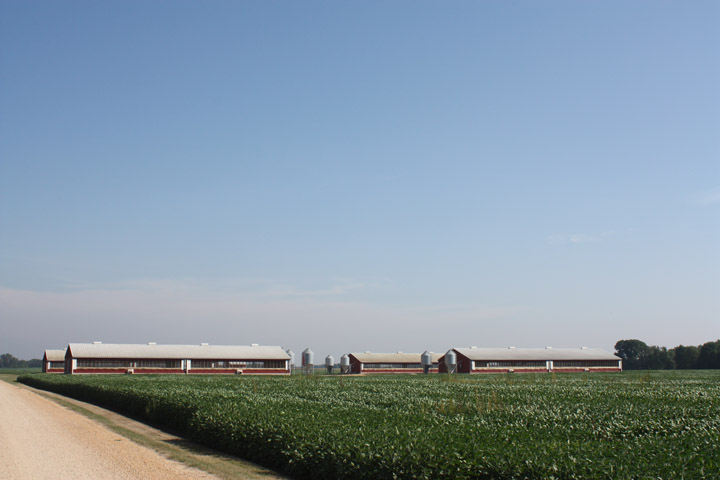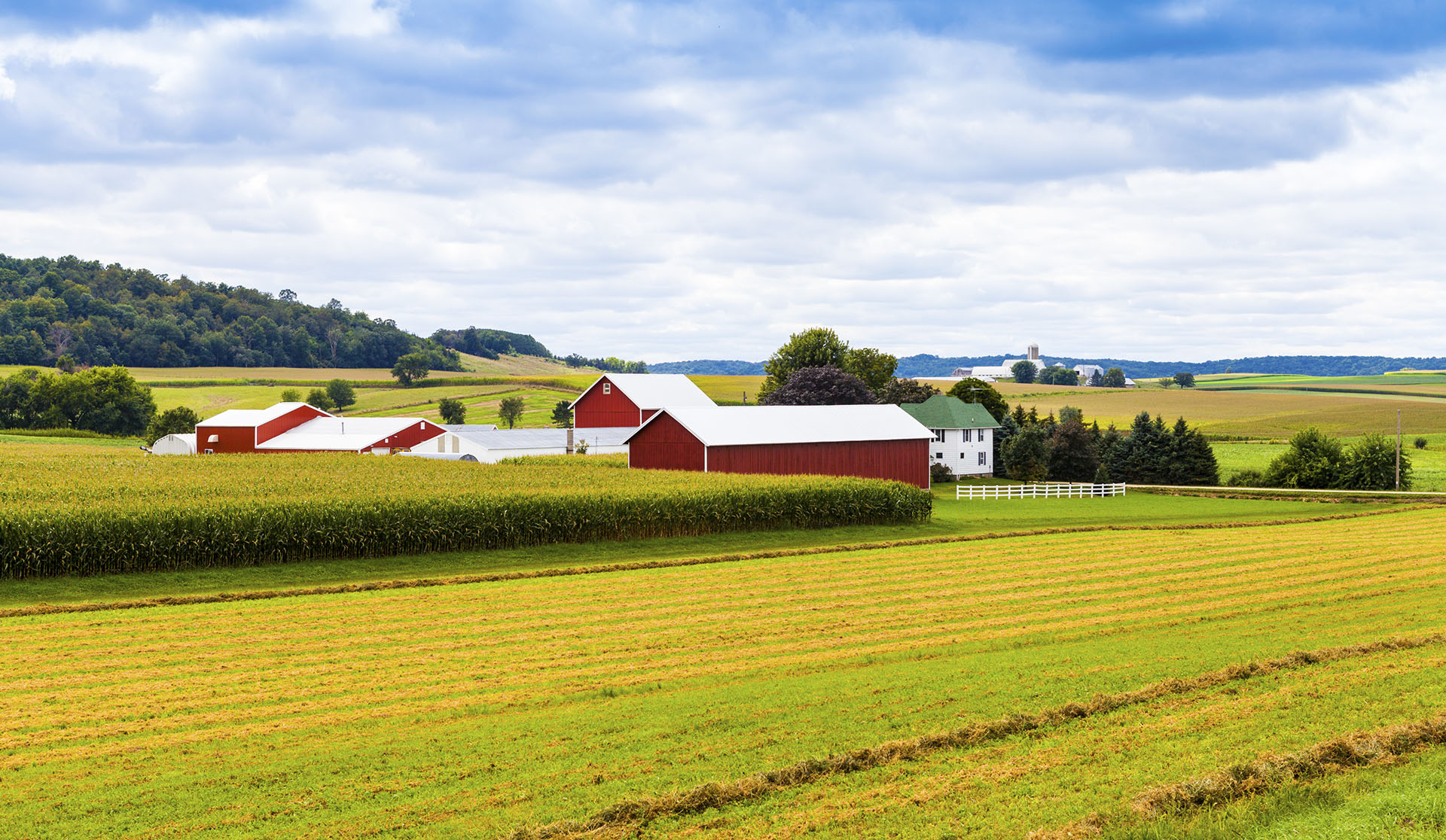
Schafer Farms is a beef and swine operation near Goodhue in Goodhue County. The swine operation consists of a 1600-sow farrow-to-wean component, producing 36,000 pigs annually. Cattle are on pasture during the growing season and overwinter on corn stalks, and annually sell 50-60 yearling bulls and 100-150 heifers. There are 160 acres of pasture and 190 acres of corn/alfalfa.

Meyer Dairy is a family dairy farm located just south of Sauk Centre in Stearns County. The family currently milk 175 cows, and own 360 acres where they grow feed for their cattle in the form of high moisture corn, corn silage and haylage.
The Discovery Farms Minnesota site at Meyer Dairy is providing information to better understand how farm management practices impact the potential for sediment and nutrient loss to surface waters.

Spring Creek Farms is a grain operation located near North Branch in Chisago County. The farm produces 700 acres of corn and 700 acres of soybeans, with a small acreage of locally sold vegetables. The farm has been a leader in soil conservation practices, have practiced no-till planting since the mid-1990s.
Discovery Farms Minnesota is providing information to better understand surface water flow, and nutrient and sediment loss in this type of operation.

Half Century Farm is a swine finishing and grain operation located in Blue Earth County. The farm grows corn and soybeans and utilizes swine manure as a source of fertilizer for the crops.
The Discovery Farms Minnesota site at Half Century Farm is providing water quality information on surface water runoff and tile drainage from a field with a corn-soybean rotation and manure application.

Minkota Holstein’s LLC is a family dairy farm located in Wright County. The family currently milks 175 cows and owns about 200 acres where they grow feed for their cattle in the form of high moisture corn, corn silage and haylage.
The Discovery Farms Minnesota site at Minkota Holstein’s LLC is designed to provide water quality information on surface water runoff and tile drainage from a field with a corn-alfalfa rotation and manure application.

The Simonsen Farm is a crop farm located in southeastern Renville County. The farm produces corn, soybean, sweet corn and peas on approximately 375 acres. This second generation farm is committed to balancing conservation and production and has a strong interest in the interaction of agricultural production practices and water quality.
The Discovery Farms Minnesota site at Simonsen Farm is designed to provide water quality information on surface water runoff and tile drainage from a field with a corn-soybean rotation and open tile intakes.

The Nordick Farm is a crop farm located in Wilkin County. The farm produces corn and soybeans in the Red River Valley. This family farm is interested in learning how farm management practices affect sediment, nitrogen and phosphorus movement.
The Discovery Farms Minnesota site at the Nordick Farm is designed to provide information to better understand how farm management practices can impact sediment and nutrient movement through tile lines in the southern Red River Valley.

Skaurud Grain Farms (SGF) is a grain operation located in northwest Minnesota, headquartered in Norman County. SGF is a diverse grain farm operation, growing sugar beet, corn, dry bean, soybean and wheat.
The Discovery Farms Minnesota project at SGF is designed to provide information to better understand how farm management practices can impact the potential for sediment and nutrient movement to surface waters in northwestern Minnesota.

The Herbst Farm is a crop and contract finishing hog farm located in Dodge County. The farm produces corn and soybeans while manure from the hogs provides nutrients for the crops. This family farm is interested in learning how farm management practices affect sediment, nitrogen and phosphorus movement.
The Discovery Farms Minnesota site at the Herbst Farm is designed to provide information to better understand how farm management practices can impact sediment and nutrient movement through surface runoff and tile lines in this region.

The Blac-X Farm is a crop and beef cattle farm located in Rock County. The farm includes a cow-calf herd with active feedlots while also producing corn, soybean, alfalfa and small grains on land that are not devoted to pasture. Blac-X Farm is interested in learning how manure management, fertilizer applications and tillage practices are affecting nutrient and sediment movement on their cropped fields.
The Discovery Farms Minnesota site at the Blac-X Farm is designed to provide information to better understand how farm management practices can impact sediment and nutrient movement through surface runoff in this region.
Curt Trost Farm

Curt Trost Farm is a grain farming operation located in Redwood County. The farm produces corn and soybeans. Currently the farming enterprise consists of 1320 acres. 20 acres where enrolled in CRP in 2013 with approximately 20 acres in woods and wetland. 100% of the acres are tiled drained. The operation was motivated to participate in the Discovery Farm Program because they want to know how fertilizer applications and tillage practices were affecting nutrient and sediment movement on their cropped fields.
The Discovery Farms Minnesota project at Curt Trost’s farm is designed to provide information that will lead to a better understanding of how farm nutrient management practices can impact sediment and nutrient movement to surface waters. It is anticipated that monitoring will continue for five to seven years. The monitoring at Curt Trost’s farm will help to identify strengths and challenges of similar farming systems and landscapes.
Griebie Farm

The Griebie Farm is a grain farming operation located in McLeod County. The farm produces corn and soybeans in rotation. The operation consists of 956 tillable acres, 54 acres in CRP with 200 acres in woods and wetlands. All acres have been tilled where needed.
The Discovery Farms Minnesota site at the Griebie Farm is designed to provide information to better understand how farm management practices can impact sediment and nutrient movement through surface runoff and tile lines in this region.
